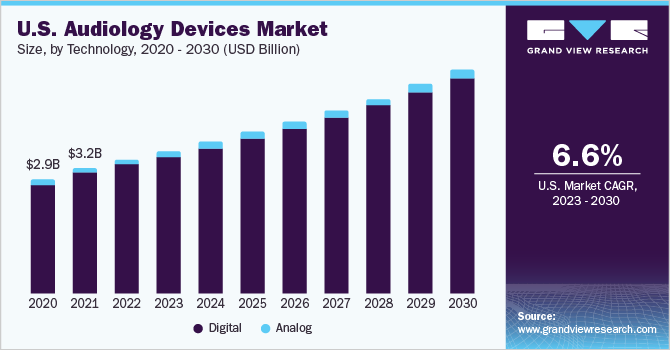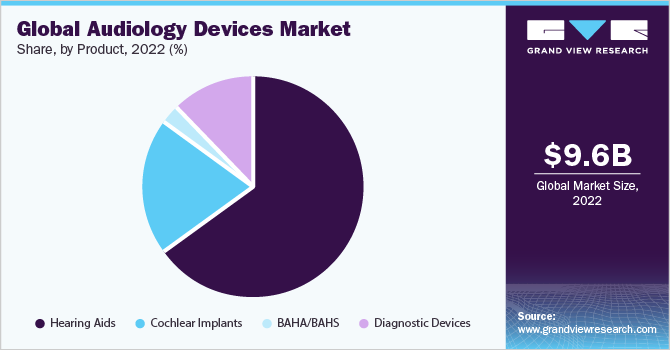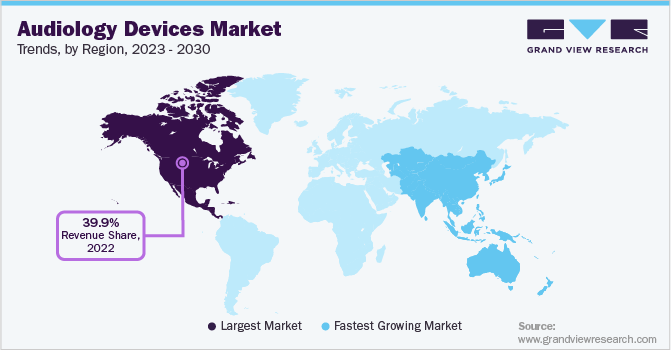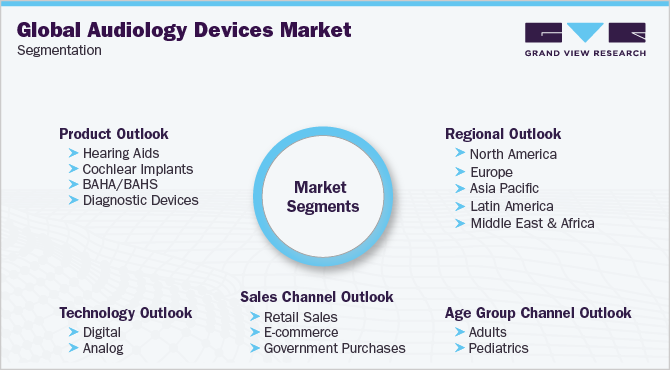- Home
- »
- Medical Devices
- »
-
Global Audiology Devices Market Size & Share Report, 2030GVR Report cover
![Audiology Devices Market Size, Share & Trends Report]()
Audiology Devices Market Size, Share & Trends Analysis Report By Technology (Digital, Analog), By Age Group (Pediatrics, Adults), By Product (Cochlear Implants, Hearing Aids), By Sales Channel, And Segment Forecasts, 2023 - 2030
- Report ID: 978-1-68038-217-4
- Number of Report Pages: 120
- Format: PDF, Horizon Databook
- Historical Range: 2016 - 2021
- Forecast Period: 2023 - 2030
- Industry: Healthcare
Report Overview
The global audiology devices market size was valued at USD 9.6 billion in 2022 and is expected to grow at a compound annual growth rate (CAGR) of 7.2% from 2023 to 2030. The industry growth can be attributed to factors, such as the growing geriatric population and cases of hearing disorders along with supportive government initiatives for easy access to hearing aid. According to the World Health Organization, approximately 2.5 billion individuals globally would suffer from some kind of hearing loss by 2050, and around 700 million individuals will seek auditory products, rehabilitation services, and hearing care if some early measures are not taken.

This is likely to boost the demand for hearing care. Increasing government initiatives to raise awareness about hearing screening among infants and older adults will foster the growth of the industry during the forecast period. In October 2020, the U.S. FDA Reauthorization Act (FDARA) amended the regulatory framework for hearing aids to form the over-the-counter category by realigning the class of hearing aids by sound conduction technology. Earlier only hearing aids by air conduction technology were defined under the OTC hearing aids. Thus, strong support from the government to improve accessibility is anticipated to drive the demand.
Rising technological advancements, such as the adoption of AI and ML and innovations in auditory products, are propelling industry growth. For instance, in October 2021, Audibel, a health-technology company, launched Arc-AI, an AI hearing aid. It is programmed to automatically adjust hearing volume and is available in various styles, such as behind-the-ear and completely-in-canal styles. In January 2019, Lively launched an online audiology platform that provides hearing aids, tests, and 24/7 online support for all clients. All users of the platform can communicate with an audiologist via video conference and receive hearing aid without the need to visit an office or retail store.
COVID-19 Audiology devices market impact: 9.0% decrease from 2019 to 2021
Pandemic Impact
Post COVID Outlook
The COVID-19 pandemic has adversely affected the industry owing to the postponement of cochlear surgeries. Furthermore, the cancellation of appointments for audiological care adversely impacted the sales of hearing aids
The industry is now stabilizing owing to the relaxation in the restrictions. The net revenues of the companies are increasing compared to the pandemic levels. For instance, Demant A/S witnessed an increase of 31.6% in sales of hearing aids in 2021
A decline in the number of cochlear surgeries impacted the overall demand for hearing implants. For instance, Cochlear Ltd. reported a 42% decline in net profitability in 2020
To overcome the negative impacts of the pandemic, companies are investing more in auditory devices with new product launch integrated with advanced technologies. For instance, in 2021, Cochlear Ltd. invested USD 195 million in the R&D of auditory devices.
Basic hearing aids perform inadequately in some public spaces. Hearing Assistive Technology (HAT) eliminates the effect of noise, distance, and reverberation by using frequency modulation, infrared, and induction loop systems. The HAT devices can be used without hearing aids or cochlear implants. The increasing demand for cost-effective products, advancements in technologies, such as wireless devices, and the rising acceptance of such technologically enhanced products are some other factors contributing to the product demand. Moreover, the rising prevalence of diseases affecting hearing, such as Meniere’s disease is anticipated to propel the growth.
As per the Hearing Health Foundation data, approximately 600,000 - 750,000 individuals in the U.S. suffer from Meniere’s disease, and 12 in 1,000 individuals globally. Around 15 to 40% of individuals reported bilateral Meniere’s disease. Many people find it difficult to accept that they have a hearing impairment or are hesitant to wear hearing aids. Low awareness, misconceptions about hearing aids, and social stigma are primary reasons for low product utilization. Hence, manufacturers are designing hearing aids that are discreet, small-sized, and barely noticeable to suit the needs of customers.
Product Insights
Based on the products, the industry is divided into hearing aids, BAHA/BAHS, cochlear implants, and diagnostic devices. Hearing aids accounted for the maximum share of 64.7% of the overall revenue in 2022 owing to the demand for invisible-in-canal hearing aids and complete-in-canal hearing aids. Cochlear implants are anticipated to witness the fastest growth of 9.5% during the forecast period. This can be attributed to the rising awareness about cochlear implants as non-invasive procedures and new products launched by key companies. For instance, in August 2021, Cochlear Ltd. launched the Nucleus Kanso-2 sound processor for a cochlear implant.

It can be employed in off-the-ear cochlear implants and is the smallest sound processor globally. It provides direct streaming from android or iOS devices and is linked to the Nucleus Smart App of Cochlear Ltd. BAHA/BAHS segment is expected to witness lucrative growth during the forecast period. This is attributed to the rising investment in BAHA/BAHS and technological innovations. For instance, in March 2021, Cochlear Ltd. received U.S. FDA approval for the Cochlear Baha 6 Max Sound Processor. It is intended to enhance hearing quality for unilateral deafness and mixed or conductive hearing loss. It is a bone conduction sound processor that provides streaming from android and iOS devices.
Sales Channel Insights
Based on the sales channel, the industry is segmented into retail stores, government purchases, and e-commerce. Retail sales segment dominated the industry in 2022 with a revenue share of 74.4% due to the presence of big retail store chains in countries, such as CVS, Walgreens, Walmart, and Amazon. They are entering into healthcare retail sector. Furthermore, the rising initiative by the government for audiology care products and remote care is expected to foster the retail stores segment during the forecast period. The e-commerce segment is projected to register the fastest CAGR of 7.2% over the forecast period.
High adoption of online stores and pharmacies, especially during the pandemic, and increasing usage of smartphones are rendering high growth to the segment. Moreover, the convenience and availability of a variety of products are responsible for increasing dependence on online channels. The government purchases segment is expected to witness lucrative growth during the forecast period owing to rising awareness about the auditory devices sold under government-funded programs. For instance, as per the Hearing Industries Association, unit sales of hearing aids by the U.S. Department of Veterans Affairs (VA) rose by 50.4% in 2021 while net unit sales by private practice and commercial channels increased by 34.0%.
Technology Insights
On the basis of technologies, the global industry has been further bifurcated into digital and analog hearing aids. The digital segment dominated the market and accounted for the maximum share of 92.8% in 2022 and is projected to grow at a fastest CAGR of 7.4% during the forecast period. This is owing to the fast adaptability of these devices. Analog hearing aids use an amplifier and microphone to intensify the sound. Some analog hearing aids are programmable and include a microchip allowing program settings for the different listening environments. Such analog devices are preferred over digital technology due to the delivery of unadulterated sound at an affordable cost.
Many manufacturers offer digital hearing aids with Bluetooth connectivity integrated with In-The-Ear (ITE) and Behind-The-Ear (BTE) models. The Open hearing aid range by Oticon can be connected with iPhone, iPad, and iPod touch devices and it allows users to stream audio directly into their hearing aids. In August 2019, Oticon launched two new digital hearing aids, Oticon Xceed power hearing aid and Oticon Xceed Play pediatric hearing aid. It is powered by the Velox S platform and is equipped with Oticon BrainHearing technology. Open sound optimizer, and Opensound Navigator. New product launches and increasing preference for digital hearing aids are anticipated to drive the growth of the segment.
Age Group Insights
Based on age group, the industry is segmented into adults and pediatrics. As per the National Institutes of Health, in December 2019, globally, approximately 736,900 cochlear implants were inserted. Around 118,100 adult devices and 65,000 pediatric devices have been implanted in the United States. The adult segment held the maximum share of 66.2% in 2022 and is projected to witness remarkable growth of 7.0% during the forecast period. The increasing geriatric population as well as awareness about available hearing implants and devices are some of the major factors contributing to the segment growth.
National Institute on Deafness and Other Communication Disorders (NIDCD) estimates that around 28.8 million American adults could benefit from hearing aids. This is likely to contribute to the expansion of the adult segment. The pediatrics segment is also anticipated to grow significantly due to the rising number of infants born with sensorineural hearing loss and the effectiveness of cochlear implants in treating these hearing abnormalities in children. In addition, according to the CDC data, 1 to 3 children out of every 1,000 suffer from hearing loss. According to other studies, there are 2 to 5 cases per 1,000 kids. South Asia has the highest prevalence of disabling hearing loss. This is anticipated to accelerate the segment growth.
Regional Insights
North America dominated the global market in 2022 with a share of more than 39.9% of the global revenue. The prominent share of the region can be attributed to the advancement in the audiology systems, an increase in the number of audiologists, and the introduction of innovative digital platforms by current providers. The launch of patient-centric audiology systems that facilitate easy product handling results in patient compliance further leading to market growth. Hearing loss affects approximately 30 million Americans and can have a substantial impact on social involvement, communication, general health, and wellbeing. Despite the widespread incidence and health implications of hearing loss, around one in five of those seeking hearing aid.

Hearing aid employment has been associated with decreases in the incidence or severity of depression, cognitive decline, and other health issues in older persons, among other health advantages. Furthermore, the usage of hearing aids can lead to increased social involvement and higher life quality. Asia Pacific is anticipated to grow at the fastest CAGR of 8.09% during the forecast period. This can be attributed to the increasing geriatric population and rising cases of age-related hearing problems. Asian countries, such as India and China have a large geriatric population, thereby rendering lucrative growth. Furthermore, constantly improving healthcare infrastructure, rising health care expenditures, and increasing product awareness are propelling the region’s growth.
Key Companies & Market Share Insights
Key companies are adopting various strategies including mergers & acquisitions, new product developments, joint ventures, and partnerships. For instance, in April 2021, Cochlear Ltd. acquired Oticon Medical, a subsidiary of Demant A/S. The deal was worth USD 170 million and will enhance the business of Cochlear Ltd. with the addition of 75,000 hearing aid recipients of Oticon Medical. Some prominent players in the global audiology devices market include:
-
Demant A/S
-
GN Store Nord A/S
-
Sonova
-
Starkey Laboratories, Inc.
-
MED-EL Medical Electronics
-
Cochlear Ltd.
-
WS Audiology A/S
-
MAICO Diagnostics GmbH
-
Oticon Medical
-
INVENTIS srl
Audiology Devices Market Report Scope
Report Attribute
Details
Market size value in 2023
USD 10.2 billion
Revenue forecast in 2030
USD 16.0 billion
Growth rate
CAGR of 7.2% from 2023 to 2030
Base year for estimation
2022
Historical data
2016 - 2021
Forecast period
2023 - 2030
Quantitative units
Revenue in USD million/billion and CAGR from 2023 to 2030
Report coverage
Revenue forecast, company ranking, competitive landscape, growth factors, and trends
Segments covered
Product, technology, age group, sales channel, region
Regional scope
North America; Europe; Asia Pacific; Latin America; Middle East & Africa
Country scope
U.S.; Canada; U.K.; Germany; France; Italy; Spain; Japan; China; India; Australia; South Korea; Mexico; Brazil; South Africa, Saudi Arabia, UAE
Key companies profiled
Demant A/S; GN Store Nord A/S; Sonova; Starkey Laboratories, Inc.; MED-EL Medical Electronics; Cochlear Ltd.; WS Audiology A/S; MAICO Diagnostics GmbH; Oticon Medical; INVENTIS srl
Customization scope
Free report customization (equivalent up to 8 analysts working days) with purchase. Addition or alteration to country, regional & segment scope.
Pricing and purchase options
Avail customized purchase options to meet your exact research needs. Explore purchase options
Global Audiology Devices Market Segmentation
This report forecasts revenue growth at the global, regional, and country levels and provides an analysis of the latest industry trends in each of the sub-segments from 2016 to 2030. For the purpose of this study, Grand View Research has segmented the global audiology devices market report on the basis of product, sales channel, technology, age group, and region:

-
Product Outlook (Revenue, USD Million, 2016 - 2030)
-
Hearing Aids
-
Cochlear Implants
-
BAHA/BAHS
-
Diagnostic Devices
-
-
Technology Outlook (Revenue, USD Million, 2016 - 2030)
-
Digital
-
Analog
-
-
Sales channel Outlook (Revenue, USD Million, 2016 - 2030)
-
Retail Sales
-
E-commerce
-
Government Purchases
-
-
Age Group channel Outlook (Revenue, USD Million, 2016 - 2030)
-
Adults
-
Pediatrics
-
-
Regional Outlook (Revenue, USD Million, 2016 - 2030)
-
North America
-
U.S.
-
Canada
-
-
Europe
-
U.K.
-
Germany
-
France
-
Italy
-
Spain
-
-
Asia Pacific
-
Japan
-
China
-
India
-
Australia
-
South Korea
-
-
Latin America
-
Mexico
-
Brazil
-
-
Middle East & Africa (MEA)
-
South Africa
-
Saudi Arabia
-
UAE
-
-
Frequently Asked Questions About This Report
b. The global audiology devices market size was estimated at USD 9.6 billion in 2022 and is expected to reach USD 10.2 billion in 2023.
b. The global audiology devices market is expected to grow at a compound annual growth rate of 7.2% from 2023 to 2030 to reach USD 16.0 billion by 2030.
b. North America dominated the audiology devices market in 2021. This is attributable to the advancement in the audiology systems, an increase in the number of audiologists, and the introduction of innovative digital platforms by current providers.
b. Some of the major companies in the global audiology devices market are Demant A/S; GN Store Nord A/S; Sonova; Starkey Laboratories, Inc.; MED-EL Medical Electronics; Cochlear Ltd.; WS Audiology A/S; MAICO Diagnostics GmbH; Oticon Medical; and INVENTIS srl.
b. Key factors that are driving the audiology devices market growth include the growing geriatric population and cases of hearing disorders along with supportive government initiatives for easy access to hearing aid. The total geriatric population in the world is estimated to be 1.4 billion by 2030.
Share this report with your colleague or friend.
![gvr icn]()
NEED A CUSTOM REPORT?
We can customize every report - free of charge - including purchasing stand-alone sections or country-level reports, as well as offer affordable discounts for start-ups & universities. Contact us now
![Certified Icon]()
We are GDPR and CCPA compliant! Your transaction & personal information is safe and secure. For more details, please read our privacy policy.
We are committed towards customer satisfaction, and quality service.
"The quality of research they have done for us has been excellent."





